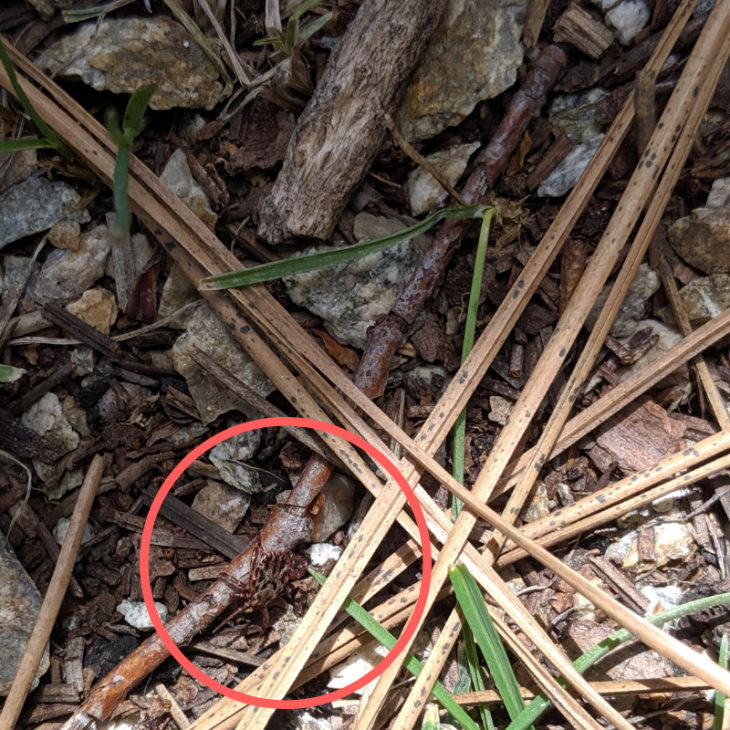A few years ago in March, my daughter was brushing her hair and something fell out. When we took a closer look, we saw that it was a tick! I picked it up and put it in a Hot Fudge jar and made her a doctor’s appointment. We took her in to get the site of the bite checked out, but also to get the tick tested. It was sent to the lab to get tested for Rocky Mountain Spotted Fever, and thankfully, tested negative for any diseases. Rocky Mountain Spotted Fever is one disease that ticks can carry that, that if not treated, can be deadly. It is rare, but not uncommon. There are less than 20,000 cases per year in the US.
Another tick-related illness is Lyme Disease, and there are about 200,000 cases in the US each year. Some other illnesses carried by ticks are Colorado Tick Fever and Tularemia. Check on the CDC website for more information regarding other tickborne diseases. I am not a medical professional. No information on this site should be relied upon to determine diet, make a medical diagnosis, or determine treatment for a medical condition. The information on this website is not intended to replace a one-on-one relationship with a qualified health care professional and is not intended as medical advice.
Tick Safety
This is the time of year that ticks are out in full force. They can be anywhere and can put your health and your pet’s health at risk. Because we always spend a lot of time camping and hiking, it’s a big risk for us. Even if you are not a person who spends time in the woods, be aware because you could accidentally pick one up in your yard or the park. Most tick bites occur in a person’s yard or garden. They can also be brought into your yard by your pets. Here are several helpful tips to prevent, recognize and remove ticks.

1. How to Recognize A Tick
How To Recognize A Tick: Ticks are very small from about 1/8 of an inch or larger, flat and have eight legs. There are many different types of ticks, depending on where you live. Not all ticks carry diseases, but you should be aware of what types live in your area. Ticks like to live in grassy, bushy or wooded areas. They can live on animals too. Just because it is not bug season, there still may be ticks. Ticks come out when it first gets warm and depending on temperatures, will remain outside all summer. My daughter’s first tick but was in March. To find out what types of ticks are common in your area, you can go here.
2. How to Prevent Ticks
Tick Prevention: When outdoors, wear bug spray that prevents ticks. These can be sprays that contain DEET, permethrin, or Lemon Eucalyptus. You can spray gear and clothing with permethrin and it will last for several washes. I do not use any DEET products and prefer to use products that contain permethrin or lemon eucalyptus. I have treated my clothing with Sawyer Permethrin Clothing Insect Repellent and also use Murphy’s Naturals Lemon Eucalyptus Oil Insect Repellent, both seem to do a good job. Do note, these are deterrents and do not guarantee that you will not get bitten, but they will reduce your chances. Insectshield is a company that sells treated clothing for pets and animals that can stand up to 70 washes. They will also treat items for you. I have a bandanna that was treated and it has worked better than most bug sprays to repel insects. Wearing a hat or long clothing can also be helpful. Most ticks that I have found, have been on the head. Also, there are certain chemicals you can spray around your yard as well as eliminating tick habitats and discouraging deer. For more tick prevention tips, you can go here.
**Update Our family had discovered in 2019 the bug repellent Proven, a natural bug repellant that not only protects against ticks but is great for keeping away other bugs as well. With the active ingredient Saltidin (Picaridin) which is a non-toxic, manufactured derivative of the black pepper plant, this bug spray is safe for children, babies, and pregnant women. It lasts up to 12 hours and our family absolutely loves it. It’s not sticky and you can get it scent-free. Proven is our number one choice when it comes to bug repellent. My son no longer looks like he has the plague from his bug bites when we go camping if we use this. This bug repellent is now one of our camping essentials.
3. How to Check for Ticks
Checking For Ticks: it is always good to check for ticks after you have been outdoors. Ticks like warm areas. For people, check the following: head and behind ears, neck, armpits, belly button, under breasts for women, behind the knees, waistband, and private areas. Take a shower if you have been outdoors. Wash clothing using hot water or put it in the dryer for 10 minutes. It has to be hot, in order to kill the tick. For pets, check the following: ears, genitalia, under the collar, between toes, and limbs. Using a brush makes it easier to detect ticks on animals. For more information on preventing ticks on animals, go here.
4. How to Remove Ticks
Tick Removal: Back in the day, you would burn a ticket to get it out. This is not recommended. The best way to remove a tick is by gently pulling it out with tweezers. Ensure that all of the tick, including the head, has been removed. Wash gently with soap and water. It is always good to save the tick, in case you get sick. If done properly, ticks can be tested for the disease. My doctor was really proud when he brought us the tick that was stuck on my daughter. He recommended keeping any ticks in an air-tight glass jar.
5. Know How to Recognize Tick-borne Illnesses
Tick Illnesses: if you are bitten by a tick, watch for a fever, or rash. If these develop, see your doctor. Rocky Mountain Spotted Fever and Lyme Disease can be easily treated if symptoms are caught early. Getting an illness from a tick depends on where you live, what type of tick bit you, and how long it was attached. If bitten by a tick, you should see a provider. Cats and dogs can also get tick-borne illnesses. The symptoms are different for animals and can take longer to manifest. For more information on tick Illnesses in animals, you can check here.
Don’t let these little bugs keep you from being outdoors. Just be aware and take the necessary steps to prevent tick bites. Keep you and your pets tick-free. For more information about what areas have ticks that carry Rocky Mountain Spotted Fever and Lyme Disease, you can go here and here. As always, be outside with no limits. Love, Pauline









Tara
This is great info! We’re outside ALL the time and I worry more about ticks since moving to NC. I was just wondering if the treated clothing actually works well. I also didn’t know you could send stuff you already own to get treated. Saving the tick if you get bit is a good thing to know too, I don’t think I would have thought of that.
Karen Moore
Ticks are not cool. We cannot buy Permethrin here in Ontario. My guy and his friend just got home from a camping trip last weekend. Three ticks were seen on them, how many were not seen. Our friend was bitten, and we are all waiting to hear the test results, Lyme disease is in our area. Not cool at all. p.s. I have an outdoors blog too. Mama Bears Backpack.
Angela Greven | Mean Green Chef
This is a terrific post, I’ve recently seen a lot on Lyme disease. I’ve never seen the Rocky Mountain tick before or knew that they have their own host of health nightmares. It’s so important to know what to watch for and how to follow through should you get bitten. Great post, thank you for sharing your knowledge! 🙂